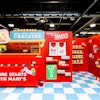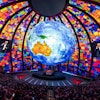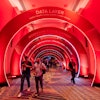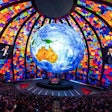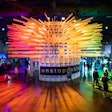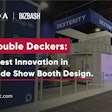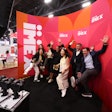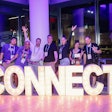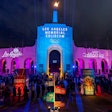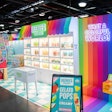"Actionable” is the keyword for trade show data, according to Jimmy Abraham, chief operating officer of event technology solutions provider enVu. “The trend is collecting data, but it’s important to set goals before the trade show to generate insights you can act on,” he says.
Event organizers looking to justify trade show expenses can use data to get a better picture of what’s working—and what needs work. Here are seven predictions to help you get the most out of trade show data in the coming year.
1. GDPR: Far Reaching on Both Sides of the Atlantic
General Data Protection Regulation will have global implications for trade show data collection, predicts Peter Gillett, CEO of Zuant, a GDPR-compliant mobile lead capture app. “There’s more to this than meets the eye,” he says. “It’s not just a right to be forgotten—it’s a right to be erased completely.” The legislation applies to worldwide collection of EU citizens’ data. According to Gillett, the key aspects are:
- obtaining opt-ins to store personal records for the purpose requested
- being able to fulfill a request to show data activity and when consent was provided
- being able to erase all contact data
The main thing is to approach the rules with positivity. “There’s so much hacking going on these days, it’s good practice to have customer data in one place and to know what data you have and where it was generated,” Gillett says.
He sees GDPR as good marketing practice, and most of Zuant’s clients agree. If you ask contacts to opt in, and ask how they prefer to hear from you, it gives a more personalized relationship than putting them on a mass-mailed list.
Even though GDPR-compliant software can handle the opt-in process, it’s important to understand the regulation. “You need someone knowledgeable in place, even if you don’t have an official data protection officer as required for EU organizations,” Gillett says. “You need good software that centralizes data and activity across all devices, and you need a good approach, but this is a positive thing if approached the right way."
2. Expect Interactive Experiences
Interactivity is the buzzword for booth displays, says Karin Roberts, director of marketing for Chicago-based The Tradeshow Network Marketing Group. She sees digital touch-screen devices that play games or showcase products as a way to draw passersby into booths.
Roberts frequently recommends the HYPEBOX as an eye-catching way to showcase products.
“The HYPEBOX is like a shadowbox; it displays a physical product inside the box and tells a story about it using digital content on an LCD display in front,” she says. “It works particularly well for high-priced products. You can lock the product in the box and bring it to life using interactive content on the screen."
It also works well with large products: You can showcase a mini version and then develop a presentation using the HYPEBOX. Roberts’ clients typically use it for two to three larger shows each year, so she recommends renting; her team hires experts to program it, install it and ensure everything runs smoothly.
3. Facial Recognition Speeds Registration
Artificial intelligence-based applications like facial recognition are likely to become more prevalent in trade shows in the coming year, foresees Robyn Davis, an Atlanta-based trade show strategy specialist. “One of the biggest pain points for attendees is queuing at registration,” she says.
Because first impressions of an event set the tone for the attendees’ overall impression of the show, facial recognition could play a key role in improving attendee perception of trade shows. Davis expects there may be some issues in wider implementation, such as privacy and reliability concerns. But she thinks facial recognition will soon be seen as standard technology.
To implement facial recognition, event organizers may consider registration providers like ExpoLogic, which allow attendees to scan their face and print their badge in a matter of seconds.
As a conference speaker, Davis is also interested in the potential future use of facial detection for events in which devices don't personally identify individuals, but can recognize faces, track their overall expression and then generate and interpret data using AI.
This can help speakers and organizers determine which segments or aspects of a presentation are most engaging. One example of this technology is offered by IBM Watson, which recently presented a session at PCMA Convening Leaders showing how they plan to implement their computer vision technology to event presentations.
4. Meeting Management Software Becomes Standard
Many exhibitors say their biggest challenge is staying on the same page as attendees regarding when and where to meet at the show. Hence, software that enables connection between attendees and brands can make a big impact at trade shows in the near future, predicts Joe Federbush, president of EVOLIO Marketing Inc. “From the show organizer’s side, it’s important they attract the right kind of attendees and add value by helping exhibitors connect with attendees and continue the dialogue after the show."
He sees meeting management software like Jifflenow fitting the bill. Whether done through an event app or software, the technology needs an application programming interface with customer-relationship management, plus marketing automation tools, to effectively nurture on-site and post-event communications.
Jifflenow’s meeting scheduling software connects buyers with sellers prior to the show. It interfaces with Salesforce and Outlook, reserves meeting times and locations, and then syncs meeting data with calendars and mobile devices. If the meeting time changes, it sends real-time alerts to all parties while automatically updating calendars and mobile devices. This helps both sides ensure the meeting actually happens, says Federbush.
It eliminates the need to manage outdated information in spreadsheets and simplifies ROI measurement. Federbush emphasizes attendees are using mobile apps as part of their everyday life, so they expect event apps and software to be a standard part of the exhibition experience.
5. Booth Monitoring Provides Attendee Insights
Trade show managers can tap into innovations in the retail world to generate insights into booth traffic, according to Abraham.
Online stores generate unprecedented amounts of data about site traffic, but retail stores have not fully tapped into in-store traffic data.
The same applies to trade show booths. Booth data, like dwell time in specific areas and number of unique visitors, can help exhibitors determine what’s effective. “This is a kind of data that has not been collected before, but can be collected now,” Abraham says. “If you have 1,000 attendees coming through but doing a quick walk-through, it’s a different story than 200 attendees each spending 10 minutes going through each part of your booth.”
One company offering booth monitoring technology is Walkbase, a sister company of enVu. Walkbase tracks attendees’ digital fingerprints—on smartphones and the like—allowing event management to count attendance, triangulate attendees’ paths through the booth and measure dwell time, without violating privacy.
The data is available live through a dashboard that updates throughout the trade show, and the software generates post-show reports. It’s important to consider your goals with the trade show, emphasizes Abraham. “The keyword is actionable data. Some people want to know what’s happening in real time so they can evolve one day to the next, while others want the overall picture."
6. Conversational AI
Chatbots have been around for 30 years, but recent artificial intelligence advances—plus proliferation of texting platforms—allow them to be deployed in events from 15 to more than 100,000 people, says Chuck Elias, CEO and co-founder of Sciensio, which provides its own chatbot solutions, called EventBots, to events nationwide. Sciensio produces Connect’s chatbot known as Connie.
“What sets chatbots apart is they let you connect one-to-one with a person. You get a complete record of what they ask, what they are looking for and what they need,” he says. “If someone texts, ‘We can’t hear the speaker,’ you can address that issue in real time.” Chatbots can handle all types of questions, including:
- From exhibitors, “When does the floor open for setup?”
- From press, “Do you have a press room?”
- From attendees, “Where’s dinner?”
Sciensio’s EventBots can tie back into a CRM or registration system to give personalized responses, so a general attendee would be told where the buffet hall is, while a VIP would be directed to the limo pickup for a special dinner. Chatbots also enable event producers to reach attendees with time-critical messages, such as to tell them about a room change, or the fire alarm that just went off was a false alarm.
7. Biometrics Open New Data Sources
Biometrics will see a huge uptick in the coming year, says Beau Ballin, vice president of business development at CWT Meetings & Events. “Wearable technology gives deeper insight than simple measurements like lead generation, or post-event surveys where everybody rates a keynote as a 5."
DatakaLab’s wearable bracelets, for instance, measure attendees’ emotional profile using their heat map, heart rate and where they’re spending their time, allowing event organizers or third-party exhibitors to get better insights about the quality of interactions. The bracelets are only available through Vibe Agency in the U.S.
“The technology is ready; pricing is low compared to RFID technology; and in beta tests, user acceptance is really high,” says Ballin. “In an event of 15,000 people, you might have 10 opt out of this due to privacy concerns."
Events, in general, are expensive—on average, a 10-by-10 trade show booth costs about $15,000 for just the booth—so executive teams are trying to answer, ‘Is this worth it?” Wearable technology gives them direct insight into the quality of an interaction, and Ballin sees it becoming widespread on trade show floors in the coming year.
